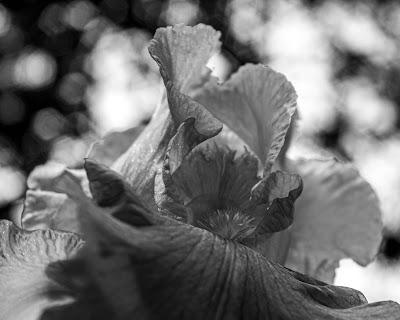Most of these observations apply to other types of flowers as well, but I’m using irises as my example.
I think of this as a “canonical” iris. The angle is square-on, showing the form perspicuously, and there is a minimum of background noise.
[Note: click on a photo to enlarge it.]

The iris in this one is in a canonical “pose,” but it’s off-center, thereby drawing attention to the active, if blurry, background. This is shot is in what I call the “urban pastoral” mode. The setting is obviously urban, but the emphasis on the iris gives the image a pastoral resonance.

This is in the urban pastoral mode as well, but involves multiple irises in the foreground.

The next three are in Georgia O’Keefe mode, where the blossom takes up almost the whole image. I could easily crop them so that the blossom fills the image-space (and I’ve got some like that).



The next three shots are in “What’s this?” mode. It’s a close-up image from an odd angle that obscures the overall shape of the blossom. These are generally taken when I’m not looking through the viewfinder. Rather, I lower the camera to a point below the blossom, angle it up, and snap the shutter when I hear the warning click. These images are hit-or-miss, but often very interesting. Notice how the gray-scale version tends to emphasize the 3D form of the blossom.



The next one is a life-and-death or life-cycle shot, showing blossoms at different stages of life.

Finally, we have a skewed image. I tend to shot rapidly, so I get a number of images that are tilted, sometimes quite badly. Depending on this and that I may rotate them in processing and I may not. The prominence of the background weighs strongly in that decision. The urban environment has a lot of strong horizontals and right-angled verticals. Do I want to preserve them or not? In this case I decided not to.


